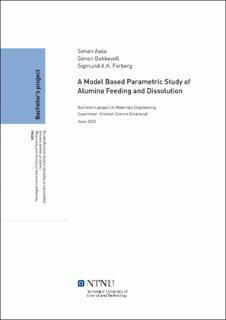| dc.contributor.advisor | Einarsrud, Kristian Etienne | |
| dc.contributor.advisor | Gylver, Sindre Engzelius | |
| dc.contributor.author | Aase, Simen | |
| dc.contributor.author | Bekkevoll, Simen | |
| dc.contributor.author | Forberg, Sigmund A.K. | |
| dc.date.accessioned | 2020-07-22T16:01:10Z | |
| dc.date.available | 2020-07-22T16:01:10Z | |
| dc.date.issued | 2020 | |
| dc.identifier.uri | https://hdl.handle.net/11250/2669916 | |
| dc.description.abstract | Alumina blir brukt som råmateriale i den energikrevende Hall-Hèroult-prosessen for produksjon av aluminium. I denne prosessen blir aluminapulver matet til et kryolittbad med jevne mellomrom. Det utfordrende miljøet i den industrielle elektrolysen gjør det vanskelig å studere enkelte fenomener som påvirker prosessen. Fysiske modeller blir av den grunn ofte brukt i forskning på området. Energikravet til prosessen vil kunne reduseres ved hjelp av raskere innløsning, samt mer effektiv mating og spredning. Denne oppgaven omhandler en modellbasert parametrisk studie av mating og innløsning av alumina, med fokus på effekten av variasjon i temperatur, partikkelstørrelsesfordeling (PSD), og gassutvikling. Eksperimentene ble gjennomført i en vannmodell og dokumentert med videokameraer. Hvert forsøk ble grundig prosessert ved hjelp av bildebehandlingsprogramvare, før resultatene ble presentert som grafer der overflatearealet til pulveret ble plottet mot flytetiden.
I løpet av de innledende eksperimentene ble det utført undersøkelser rundt pulverfastsettelse til vannmodell forsøkene for å simulere alumina, med Natreen strøsukker som et velegnet resultat. Optimalisering av vannmodellen for å øke dens likhet til industrielle celler ble også utført under disse eksperimentene.
Resultatene fra vannmodellen viste viktigheten av PSD i forhold til flytetid. PSD med en stor andel fine partikler ga økt flytetid med gjennomsnitt mellom 240 og 550 sekunder. Eksperimentene med en lavere andel fine partikler viste en gjennomsnittlig flytetid mellom 35 og 135 sekunder. Resultatene indikerer i tillegg at en økning i temperatur og gassutvikling vil gi raskere innløsning og redusert flytetid.
Det ble konkludert med at valg av pulver og modelloptimalisering har vært vellykket, samt at det har blitt oppnådd resultater i vannmodellen med likheter til tidligere studier. En hel-automatisert metode for etterbehandling av videoer ble ikke oppnådd, ettersom lysforhold viste seg å være en større utfordring enn først antatt.
Til slutt er det lagt frem forslag til videre arbeid. Disse har fokus på mer nøyaktig kontroll av PSD og nærmere undersøkelser av hvilke faktorer som kan bidra til automatisering av bildebehandlingen. | |
| dc.description.abstract | In the Hall-Hèroult process, alumina is used as the raw material in the energy-intensive production of aluminium, where alumina powder is fed into a bath mainly consisting of molten cryolite. Environmental challenges in the industrial electrolysis cell makes some phenomena affecting the process hard to fully investigate, thus physical models in laboratories are often used for research. A faster dissolution of alumina, with an efficient feeding and dispersion of the powder, has several benefits for the process. This thesis conducts a model based parametric study of alumina feeding and dissolution, where the effect of variations in temperature, particle size distribution (PSD) and gas evolution are considered. The experiments were carried out in a water model and recorded for documentation. Every recorded experiment was thoroughly processed and the results are presented as charts where surface area of the floating powder is plotted against the floating time.
Investigations on determining a powder to simulate alumina in the water model was conducted in the initial experiments, with the discovery of crushed Natreen sprinkle sugar as a well-suited outcome. Optimizing the water model to increase its resemblance to industrial cells were also performed during these experiments.
Results from the water model tests showed the importance of the PSD upon floating time. A PSD with a high amount of fines increased the floating time significantly and gave a mean floating time between 240 to 550 seconds. In comparison, the PSD with a small amount of fines had a mean floating time in the range of 35 to 135 seconds. It was also indicated through Minitab results that an increase in temperature and gas flow had positive effects on the dissolution rate, meaning a reduction in floating time.
It was concluded that the work regarding powder determination and model optimization was successful and results which indicated similarities with previous studies were obtained. Though measures were taken, a fully automated image analysis was not achieved.
Suggestions for future research on water model experiments are presented, with the focus on a more precise PSD management for the powder used and the overall conditions that may lead to a more automated image analysis. | |
| dc.publisher | NTNU | |
| dc.title | A Model Based Parametric Study of Alumina Feeding and Dissolution | |
| dc.type | Bachelor thesis | |
